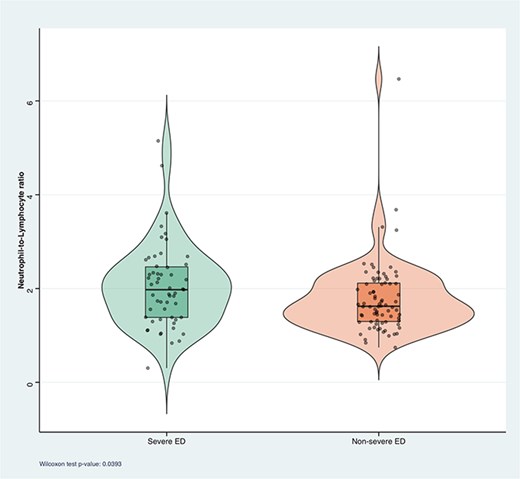-
PDF
- Split View
-
Views
-
Cite
Cite
E Pozzi, F Negri, F Belladelli, A Bertini, C Corsini, M Raffo, M Malvestiti, M Oddo, G Birolini, L Boeri, A D'arma, F Montorsi, A Salonia, NEUTROPHIL-TO-LYMPHOCYTE RATIO AS A NOVEL MARKER OF ERECTILE DYSFUNCTION BURDEN: FINDINGS FROM A REAL-LIFE CROSS-SECTIONAL STUDY, The Journal of Sexual Medicine, Volume 22, Issue Supplement_2, May 2025, qdaf077.092, https://doi.org/10.1093/jsxmed/qdaf077.092
Close - Share Icon Share
Abstract
The neutrophil-to-lymphocyte ratio (NLR) is an indicator of systemic inflammation in various pathological conditions. Data regarding its role as marker of endothelial dysfunction in erectile dysfunction (ED) have been scantily analyzed. We aimed to investigate the association between NLR, ED severity, and comorbidities in patients with ED.
Complete data from 273 consecutive patients seeking first medical help at a tertiary academic center between 2006 and 2024 for ED only were analyzed. Comorbidities were scored using the CCI. All patients completed the IIEF questionnaire and ED severity was categorized according to Cappelleri criteria. NLR was calculated from baseline blood tests for each patient. The entire cohort was segregated into two groups according to ED severity - severe ED [IIEF-EF < 11] vs. non-severe ED[IIEF-EF > 11]. Full matching was employed to balance potential confounders between groups, to minimize bias. Descriptive statistics were used to compare patients with severe ED vs. non-severe ED. Linear and logistic regression analysis tested the association and predictivity of NLR to severe ED.
Overall the median (IQR) age was 52 (43-60) years. The median (IQR) NLR, BMI, total testosterone and IIEF-EF were: 1.7 (1.3-2.3), 25.6 (23.3-27.9) kg/m2, 473 (310-599) ng/dL and 13 (7-22) respectively. After propensity score matching, 55 patients with severe ED were balanced with 55 non-severe ED patients across all measured covariates (all p > 0.05), including age, BMI, comorbidities, serum hormones, lipid profiles and C-reactive protein. Patients with severe ED demonstrated higher median (IQR) NLR values compared to those with non-severe ED 1.98 (1.38, 2.46) vs 1.62 (1.30, 2.12), p = 0.03, Fig. 1. At linear regression analysis NLR was directly associated with IIEF-EF domain (Coeff. 0.11, p = 0.01). At multivariate logistic regression analysis NLR was identified as a predictor of severe ED (OR: 0.59, 95% CI: (0.44-0.78), p = 0.0003).
In this matched cohort, elevated NLR was significantly associated with severe ED. NLR demonstrated both a direct relationship with ED severity and predictive capacity for severe ED. These findings suggest that NLR may serve as a marker of ED severity, highlighting a heightened state of inflammation in men with severe ED.
None.




